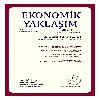Currency substitution as a built-in de-stabilizer
Para ikamesi yerleşik bir istikrar bozma mekanizması olabilir mi?
___
- BAHMANI-OSKOOEE, M, DOMAÇ, İlker (2003), "On the Link betWeen Dollarisation and Inflation: Evidence from Turkey" Comparative Economic Studies Vol. 45, No. 3, 306-328.
- CALVO, Guillermo,VEGH, Carlos (1992), "Currency Substitution in Developing Countries: An Introduction", IMF Working Papers, No. 92 (40).
- CİVCİR, İrfan (2003), "Money Demand, Financial Liberalization and Currency Substitution in Turkey", Journal of Economic Studies, Vol. 30, No. 5, 514-534.
- EATWELL, John, TAYLOR, Lance (2000), Global Finance at Risk: The Case for International Regulation, New Press, New York.
- EMİRMAHMUTOĞLU, Furkan, Nezir KÖSE ve Yeliz YALÇIN (2005), "Birim Kök Testlerinde Yapısal Kırılma Zamanının İçsel Olarak Belirlenmesi Problemi: Alternatif Yaklaşımların Performansları", VII. Ulusal Ekonometri ve İstatistik Sempozyumu , İstanbul Üniversitesi.
- ERTÜRK, Korkut (2005), "Economic Volatility and Capital Account Liberalization in Emerging Economies", International Review of Applied Economics, Vol. 19, No. 4, 399-417.
- HARRIS, Richard (1995), Using Cointegration Analysis in Econometric Modeling. UK: Prentice Hall, London.
- GUJARATI, Damodar (2007), Basic Econometrics, New Delhi: Tata McGraw-Hill.
- KEYNES, John Maynard (1937), "The General Theory of Employment", Quarterly Journal of Economics, Vol. 51, No. 2, 209-223.
- KRUGMAN, Paul (1979), "A Model of Balance of Payments Crises" Journal of Money Credit and Banking, Vol. 11, No. 3, 311-325.
- KRUGMAN, Paul (1999), "Balance Sheets, the Transfer Problem and Financial Crises", International Tax and Public Finance, Vol. 6, No. 4,459-472.
- McKINNON, Ronald, I, PILL, Huw (1998), "The Over Borrowing Syndrome: Are East Asian Economies Different?" In Exchange Rates and Capital Flows in the Pacific Basin, ed. R. Glick, Cambridge University Press, Cambridge, pp 187-212.
- NILSSON, Isabelle (2009), "Unit Root Tests and Structural Breaks in the Swedish Electricity Price", Unpublished Masters's Thesis.
- RANGVID, Jasper (2002), "Second Generation Models of Currency Crises", Journal of Economic Surveys, Vol. 15, No. 5, 613-646.
- SELÇUK, Faruk (1994), "Currency Substitution in Turkey", Applied Economics, Vol. 26, No. 5, 509-518.
- ZIVOT, E., ANDREWS, W.K. (1992), "Further Evidence on the Great Crash, the Oil Price Shock and the Unit-Root Hypothesis", Journal of Business and Economic Statistics, Vol. 10, No. 3, 251-70.
- ISSN: 1300-1868
- Yayın Aralığı: 3
- Yayıncı: Ekonomik Yaklaşım Derneği
"Mağdur" milliyetçilik kürt siyasetinin "demokratik" zaafiyeti ve ulus açmazı
Türk otomotiv sektöründe yoğunlaşma: Binek ve hafif ticari araçlar üzerine bir uygulama
Yılmaz Onur ARİ, Selahattin KAYNAK
Currency substitution as a built-in de-stabilizer
Avrupa karbonatlı içecekler piyasasında firma büyüklüğü ve büyüklük genişleme oranı ilişkisi
